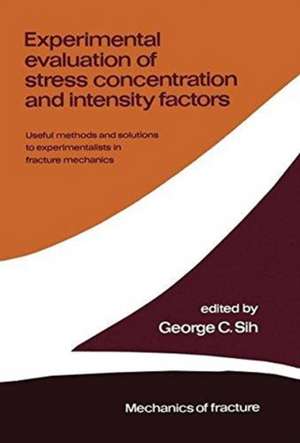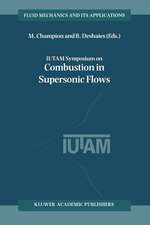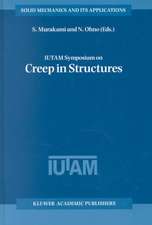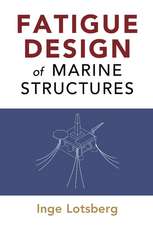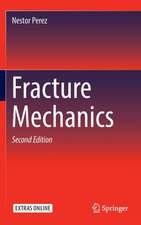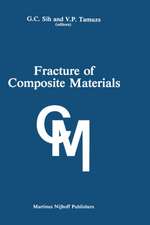Experimental evaluation of stress concentration and intensity factors: Useful methods and solutions to Experimentalists in fracture mechanics: Mechanics of Fracture, cartea 7
Editat de George C. Sihen Limba Engleză Hardback – 30 noi 1981
| Toate formatele și edițiile | Preț | Express |
|---|---|---|
| Paperback (1) | 1236.82 lei 6-8 săpt. | |
| SPRINGER NETHERLANDS – 3 oct 2013 | 1236.82 lei 6-8 săpt. | |
| Hardback (1) | 1057.30 lei 39-44 zile | |
| SPRINGER NETHERLANDS – 30 noi 1981 | 1057.30 lei 39-44 zile |
Preț: 1057.30 lei
Preț vechi: 1391.18 lei
-24% Nou
Puncte Express: 1586
Preț estimativ în valută:
202.32€ • 220.65$ • 170.59£
202.32€ • 220.65$ • 170.59£
Carte tipărită la comandă
Livrare economică 21-26 aprilie
Preluare comenzi: 021 569.72.76
Specificații
ISBN-13: 9789024725588
ISBN-10: 9024725585
Pagini: 414
Ilustrații: LVI, 354 p.
Dimensiuni: 152 x 223 x 31 mm
Ediția:1981
Editura: SPRINGER NETHERLANDS
Colecția Springer
Seria Mechanics of Fracture
Locul publicării:Dordrecht, Netherlands
ISBN-10: 9024725585
Pagini: 414
Ilustrații: LVI, 354 p.
Dimensiuni: 152 x 223 x 31 mm
Ediția:1981
Editura: SPRINGER NETHERLANDS
Colecția Springer
Seria Mechanics of Fracture
Locul publicării:Dordrecht, Netherlands
Public țintă
ResearchCuprins
1 Stress concentrations.- 1.1 Introduction.- 1.2 Advantages and disadvantages of stress analysis methods used to determine stress concentrations.- 1.3 Compilation of results.- 1.4 Geometrically non-linear stress concentrations.- 1.5 Stress concentrations in mixed boundary value problems.- 1.6 Stress concentrations in some specific problems.- 1.7 Stress concentrations in three-dimensional problems.- 1.8 Dynamic stress concentrations.- 1.9 Unconventional approaches to the study of stress concentrations.- References.- 2 Use of photoelasticity in fracture mechanics.- 2.1 Introduction.- 2.2 Analytical foundations for cracked bodies.- 2.3 Experimental considerations.- 2.4 Application of the frozen stress method.- 2.5 Summary and conclusions.- References.- 3 Elastic stress intensity factors evaluated by caustics.- 3.1 Introduction.- 3.2 The basic formulas.- 3.3 The equations of caustics.- 3.4 Properties of the caustics at crack tips.- 3.5 The case of birefringent media.- 3.6 The case of anisotropic media.- 3.7 Interacting crack problems.- 3.8 Branched crack problems.- 3.9 Interface crack problems.- 3.10 V-notch problems.- 3.11 Shell problems.- 3.12 Plate problems.- 3.13 Other applications.- 3.14 Discussion.- 3.15 Conclusions.- References.- 4 Three-dimensional photoelasticity: stress distribution around a through thickness crack.- 4.1 Introduction.- 4.2 Hartranft-Sih plate theory.- 4.3 Triaxial crack border stress field.- 4.4 Experimental considerations: specimens and materials.- 4.5 Test procedure: frozen stress technique.- 4.6 Comparison of Hartranft-Sih theory with experiments.- References.- 5 Experimental determination of dynamic stress intensity factors by shadow patterns.- 5.1 Introduction.- 5.2 Physical and mathematical principles of the method.- 5.3 Theoretical analysisof the shadow pattern after Manogg: Mode-I-loaded stationary crack.- 5.4 Validity of the analysis for stationary cracks under dynamic loading.- 5.5 The dynamic correction for propagating cracks.- 5.6 Experimental technique and evaluation procedure.- 5.7 Applications.- 5.8 Concluding remarks.- References.- 6 Experimental determination of stress intensity factor by COD measurements.- 6.1 Introduction.- 6.2 Principle of the interference optical technique.- 6.3 Determination of stress intensity factor from crack opening displacement.- 6.4 Conclusion.- References.- Author’s Index.
